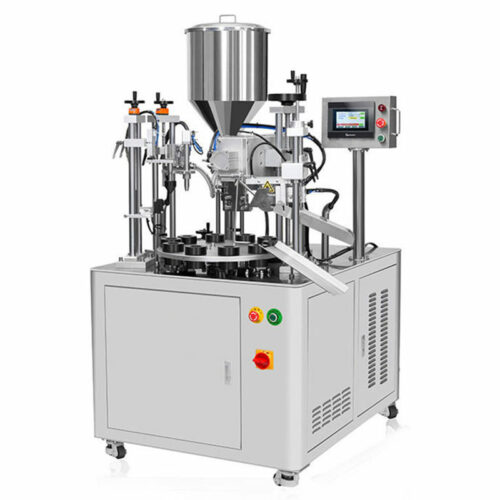Ultrasonic Tube Filling Sealing Machine with a highly automatic operation and runs smoothly. It can automatically filling paste, sealing tube, printing date or batch and trimming tube, saving space and improving work efficiency. The unique one-headed design is easier to clean. More convenient to size changing and simpler to control.
These machines are commonly used in industries where precise and efficient packaging is required, such as in the pharmaceutical, cosmetic, and food industries. The use of ultrasonic sealing offers advantages such as speed, precision, and the ability to seal tubes without the need for additional heat sources or adhesives.
Features:
- Adopts ultrasonic sealing technology, no need warm up time, more stable and neat sealing, no distortion and low reject rate less than 1%.
- Manually feed the tube, press start button, machine could automatically identify the registration mark, sealing (with coding), end trimming.
- PLC with touch screen control system, providing friendly operation experience.
- Made of 304 stainless Steel, acid and alkali resistance, corrosion resistance.
- Human-machine operation, the operation is easy and the whole running is stable.
- Suitable for medicine, foods, cosmetics, daily chemical industry.
How Ultrasonic Tube Filling Machine Works?
- Tube Loading: Empty tubes are loaded into the machine. These tubes are typically made of materials like plastic or metal.
- Filling: The machine dispenses the product into the tubes. The type of product being filled can vary widely, from creams and gels to pastes and ointments.
- Ultrasonic Sealing: Once the tubes are filled, they move to the sealing station. Ultrasonic sealing involves applying high-frequency vibrations to the tube material. The vibrations generate heat, causing the material of the tube to melt and fuse together. This creates a strong and airtight seal.
- Trimming: After the ultrasonic sealing process, excess material may be present at the sealed end of the tube. A trimming mechanism is often incorporated to remove any excess material, ensuring a clean and finished appearance.
- Coding/Marking (Optional): Some machines may include an additional station for coding or marking the tubes. This is where information like batch numbers, expiration dates, or other product-related details are imprinted onto the tube.
- Tube Ejection: Once the filling, sealing, and optional coding processes are complete, the filled and sealed tubes are ejected from the machine.

 Tube Filling Machine
Tube Filling Machine Cartoning Machine
Cartoning Machine Cup Filling Machine
Cup Filling Machine Coffee Capsule Machine
Coffee Capsule Machine Filling Capping Machine
Filling Capping Machine Labeling Machine
Labeling Machine Sachet Packing Machine
Sachet Packing Machine Other Machines
Other Machines











